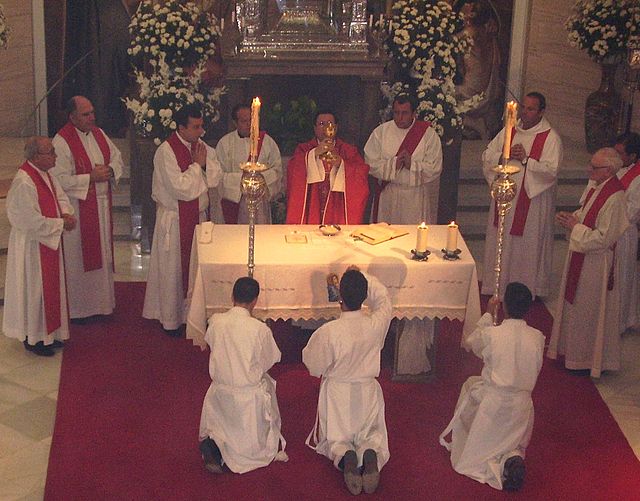
Liturgy Of The Word: The Priest’s Kisses During Mass
The priest’s kisses during the Holy Mass have meaning. The body participates in the liturgy on the same level as the intellect and emotion
The liturgy of the Holy Mass involves all of us. And it involves a rituality of gestures that is dense with meaning, both on the part of the assembly and the celebrant.
The General Introduction of the Roman Missal ( IGMR ) at point 42 says:
“The gestures and bodily postures of both priest, deacon and ministers, as well as of the people, must tend so that the whole celebration shines with noble decorum and simplicity, so that the true and full meaning of each is understood”.
The body therefore participates in the liturgy on the same level as the intellect and emotion.
It is difficult to imagine that the Eucharist, at the centre of which we hear: ‘this is my body’, could ignore our corporeity throughout its celebration.
The priest’s three or even four kisses during Holy Mass
Standing, sitting, kneeling, signs of the cross, other gestures, words, chants, iconography that appeal to the sense of sight, sometimes even the smell of incense.
All this refers mainly to our body with its senses.
Among the many signs with which our liturgy is interwoven, there are also kisses: in the current form of the liturgy of the Holy Mass, there are three or even four.
The first of the priest’s kisses celebrates loving union
First, the priest celebrating Mass kisses the altar .
This happens at the beginning of the liturgy, immediately after reaching the altar.
In fact, before the mass itself begins.
It is not only a sign of reverence and respect, but also of tenderness and closeness typical of a relationship based on love.
This kiss tells us what we are really celebrating: the meeting of people who love each other, God and us.
A sign of the Church, the Bride of Christ, is also the priest kissing the altar at the threshold of the liturgy.
With this gesture she expresses that she has come to meet the Beloved and to feed on his love .
And it is like the sign of Christ kissing the lips of his Bride, although she herself would be inclined to believe that her place is at his feet at most.
The second of the priest’s kisses expresses gratitude
The second liturgical kiss is placed by the priest or deacon on the book from which he has just read the Gospel, immediately after saying: here is the ‘Word of God’.
Kissing the book, he says under his breath: “May the words of the Gospel take away our sins”.
It is a symbolic kiss .
Because if I wanted to kiss the Word of God, the Gospel, I would have to kiss the ears of those gathered at that moment.
He then symbolically kisses the book, expressing gratitude that the Lord speaks to us; that his Word accompanies us in every situation in life; that it has the power to purify and transform us; that “God wanted to save believers through the foolishness of preaching” ( 1 Corinthians 1:21 ).
Third kiss to show universal affection
The third kiss can clash for cultural reasons.
Many apostolic letters end with an invitation to the recipients to “greet each other with a holy kiss” (cf. Rom 16:16; 1 Cor 16:20; 2 Cor 13:12; 1 Thess 5:26; 1 Pet 5:14). . ).
Even today, in many parts of the world, a kiss is a way of showing affection (e.g. in greeting).
It is, of course, time to express the so-called sign of peace .
The form of this sign is adapted to the sensitivity of the local community.
However, there is nothing to prevent us from giving a sign of peace in this way with those close to us, if we stand side by side during Mass.
The embrace that priests celebrating mass together often give each other at this time is basically a substitute for this kiss of peace.
The priest’s last kiss is a farewell kiss at the altar
The last kiss is still the one given by the priest at the altar, after the people have been dismissed.
It is a kind of ‘goodbye’ from the altar, which makes us see the liturgy that has just ended, not as a ‘fulfilled’ duty, but as an encounter that is coming to an end; that will be missed and that requires some continuation in the time following the liturgy.
Like any other encounter important to us, we live after its end, waiting for the next one.
Read Also
What Does It Take To Be A Nun?
My Mission As Ambassador Of The Works Of Mercy In Spazio Spadoni
Congo, The Right To Drinking Water And The Well In The Village Of Magambe-Isiro
Volontariato In Congo? E’ Possibile! L’esperienza Di Suor Jacqueline Lo Testimonia
Vangelo Di Domenica 16 Aprile: Giovanni 20, 19-31
Pasqua 2023, È Tempo Di Auguri A Spazio Spadoni: “Per Tutti I Cristiani Rappresenta La Rinascita”
Testimonianza Di Suor Giovanna Chemeli: “Spazio Spadoni…Uno Spazio Anche Per Me!”
Dall’Italia Al Benin: Suor Beatrice Presenta Spazio Spadoni E Le Opere Di Misericordia
Suor Angelita Jacobe: L’opera Di Misericordia Che Ho Trovato In Spazio Spadoni
Loppiano, Sorella Esperance Nyirasafari: “Il Mio Soggiorno In Italia”
Pearl And Angelica: The Two Sisters With Rosolini’s Mercy
Spazio Spadoni, Il Fondatore Luigi Spadoni Insignito Della Cittadinanza Onoraria Di Rosolini
Caritas Internationalis Elects Alistair Dutton As Its New Secretary General
